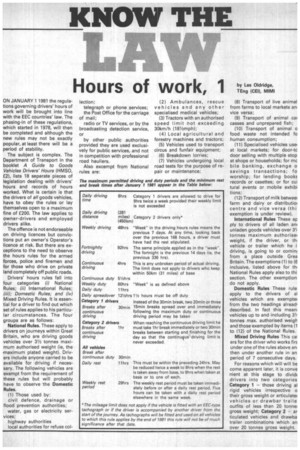Hours of work, 1
Page 55

If you've noticed an error in this article please click here to report it so we can fix it.
ON JANUARY 1 1981 the regulations governing drivers' hours of work will be brought into line with the EEC countries' law. The phasing-in of these regulations, which started in 1978, will then be completed and although the new rules may not be exactly popular, at least there will be a period of stability.
The subject is complex. The Department of Transport in the booklet A Guide to Goods Vehicles Drivers' Hours (HMSO, £2), lists 18 separate pieces of legislation dealing with drivers' hours and records of hours worked. What is certain is that the drivers of all goods vehicles, have to obey the rules or lay themselves open to a maximum fine of £200. The law applies to owner-drivers and employed drivers alike.
The offence is not endorseable on driving licences but convictions put an owner's Operator's licence at risk. But there are exceptions to the need to observe the hours rules for the armed forces, police and firemen and for those who drive on private land completely off public roads.
Drivers' hours rules fall into four categories (7) National Rules; (ii) International Rules; (iii); Domestic Rules; and (iv) Mixed Driving Rules. It is essential for a driver to find out which set of rules applies to his particular circumstances. The four groups are as follows:
National Rules. These apply to drivers on journeys within Great Britain, who are driving goods vehicles over 31/2 tonnes maximum authorised weight (ie, the -maximum plated weight). Drivers include anyone carried to be available for driving if necessary. The following vehicles are exempt from the requirement of these rules but will probably have to observe the Domestic Rules.
(1) Those used by: civil defence, drainage or flood prevention authorities; water, gas or electricity services; highway authorities
local authorities for refuse col
lection; telegraph or phone services; the Post Office for the carriage of mail; radio or TV services, or by the broadcasting detection service, or by other public authorities provided they are used exclusively for public services, and not in competition with professional road hauliers.
Also excempt from National rules are: (2) Ambulances, rescue vehicles and any other specialised medical vehicles;
(3) Tractors with an authorised speed limit not exceeding 30km/h (181/2mph);
(4) Local agricultural and forestry machines and tractors; (5) Vehicles used to transport circus and funfair equipment; (6) Breakdown lorries; (7) Vehicles undergoing local road tests for the purpose of repair or maintenance;




























































































































